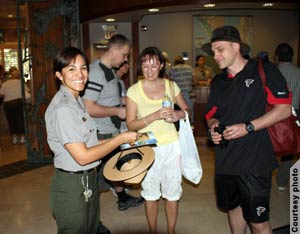
U.S. embassy and consulate websites or www.state.gov.
We’ve gone social!
Follow us on our facebook pages and join the conversation.
14 March 2011
Russian Officials Examine U.S. Park Management in Florida

Washington — Mangrove forests, sawgrass prairies, immense longleaf pine woodlands, freshwater springs, and savanna grasslands — all part of the Florida landscape, and all permanently protected as national parks and forests — formed the backdrop for 20 Russian officials who recently observed firsthand how the United States manages such environmentally sensitive areas.
The February 23–March 3 visit to several federally protected sites throughout the state of Florida allowed the Russian delegation insight into issues such as wildlife conservation, resource management, the role of volunteerism and the balance between public access and environmental conservation.
The delegation included 14 park and natural reserve managers, officials from the Russian Ministry of Natural Resources and Environment, and representatives from environmental nongovernmental organizations (NGOs). Their visit to Florida followed discussions with the National Park Service, the U.S. Forest Service and the Fish & Wildlife Service in Washington.
With legislation under consideration in the Russian Parliament that would provide greater public access to that nation’s parks and nature reserves, the Russian officials were interested in learning how the United States handles multiple uses of, and multiple demands on, its protected federal lands.
APALACHICOLA NATIONAL FOREST
At the Apalachicola National Forest, a 2,311-square-kilometer preserve in northern Florida that encompasses six watersheds and botanical riches ranging from vast savannas to stands of virgin cypress and pine, the Russian visitors received an in-depth explanation of the U.S. Forest Service’s management of these environmental resources.
Chuck Hess, a wildlife biologist at Apalachicola, spoke to the delegation during its daylong visit about local ecology, the natural role fire plays in it, managing the forest to ensure biodiversity, and recreational opportunities for the public that include canoeing, horseback riding, hunting, fishing, mountain biking, and bird-watching.
According to Hess, the Russian visitors seemed particularly intrigued by the forest’s wildlife, especially the alligators they frequently saw.
“I was able to catch a pygmy rattlesnake to demonstrate the smaller reptiles of the area,” Hess said. “In most groups, snakes are always avoided by at least part of the group. However, in this case everybody seemed attracted, which I found surprising.”
The Russian delegation hiked part of the Florida National Scenic Trail, a 2,240 kilometer-long trail that stretches from the edge of the Everglades in southern Florida to the Gulf Islands National Seashore on the state’s northern Gulf of Mexico coast. During this hike along the trail’s Aucilla River Sinks segment, a stretch of river that disappears underground and reappears several times in the area’s limestone karst geology, the Russian officials were briefed on the importance of volunteer efforts and private-public partnerships to establish and manage the trail.
EVERGLADES NATIONAL PARK

Learning about restoration efforts and the challenges of managing the Everglades wetlands ecosystem formed the major focus of the Russians’ subsequent program at three national park units in southern Florida — Everglades National Park, the adjoining Big Cypress National Preserve and nearby Biscayne National Park.
At Everglades National Park, the Russian officials were particularly interested in the U.S. parks system’s law-enforcement training, equipment and practices. Fire management was another topic of interest, with Everglades fire management officer Rick Anderson explaining how the parks staff set prescribed fires to reduce the combustible fuel supply and create firebreaks to reduce the impact from fires originating outside the park.
The rich biological diversity of the Everglades also proved fascinating, especially on a walk along the park’s famed Anhinga Trail, where the Russian visitors were surprised to see wildlife right next to the walking path.
“Four species of birds, alligators, and all in one photo!” exclaimed one member of the delegation.
BIG CYPRESS AND BISCAYNE
At Big Cypress, ranger Bob DeGross briefed the delegation on multiple use issues, such as the oil and gas leases within the preserve’s boundaries, as well as how Native American tribes indigenous to the area such as the Seminole and Miccosukee are still permitted subsistence hunting, fishing and trapping inside that park.
Biscayne National Park, one of only a few protected marine reserves within the U.S. national park system, was the delegation’s final destination. The program there centered on the impact a rise in sea levels induced by climate change would have on the park, the beneficial role of volunteers, and the concept of using parks as classrooms for environmental education.
The Russian officials took away from their U.S program several concepts of managing protected areas they believe can be adapted for use in their own national parks and nature preserves.
These include access for the handicapped, programs for children, signs indicating what activities are permitted rather than just banned, educational signs along park trails, and the interpretative displays found within visitor centers.
U.S.-RUSSIAN EXCHANGES
Rudy D’Alessandro, an official with the National Park Service who accompanied the delegation to southern Florida, spoke of the value such exchanges can have. Although officials from the Park Service, the U.S. Forest Service, and the Fish & Wildlife Service were already scheduled to visit Russia in the coming three to six months, he said these U.S. agencies hope to arrange with the Russian Ministry of Natural Resources and Environment a reciprocal visit to Russia as a separate follow-up to the Russian parks managers’ U.S. program.
D’Alessandro called this just-concluded program “invaluable for me and the Park Service to re-establish formal and informal relationships with our Russian colleagues.”
“When you’re breaking bread over an alligator-infested creek,” he said, “you really get the chance to discuss common concerns in a friendly and informal manner.”
(This is a product of the Bureau of International Information Programs, U.S. Department of State. Web site: http://www.america.gov)
